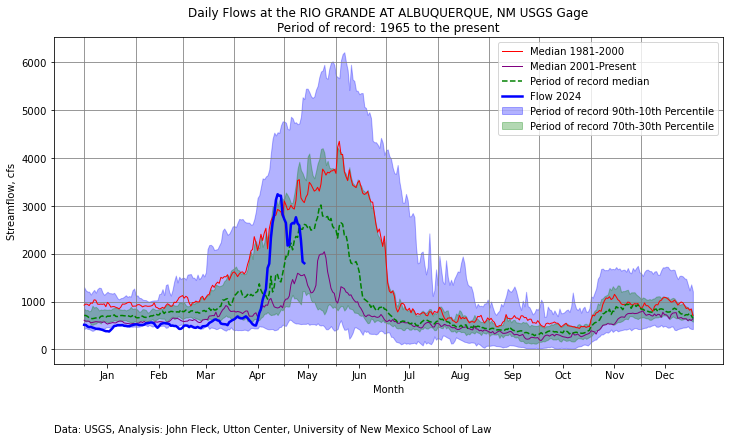We’ll get an update on the status of El Vado Dam and related issues at this afternoon’s (Mon. 5/13/24) meeting of the Middle Rio Grande Conservancy District’s board of directors. This is an enormously consequential issue for Rio Grande flows through central New Mexico.
The Meeting
Today’s board meeting starts at 3 p.m. at the District’s main offices, 931 Second Street SW in Albuquerque (between the National Hispanic Cultural Center and Bueno Foods, a bit of geography I’ve always loved). The first substantive item on the agenda is a presentation by Wayne Pullan, the Bureau of Reclamation’s Upper Colorado River Regional Director. This is a clue. Regional directors suggest an elevation in the issue’s importance. (Zoom link can be found here.)
The Dam
Built in the 1930s, the dam is a critical piece of infrastructure for managing the river’s flow. Built to store water during the high spring runoff season for use in late summer and fall, it is critical for both irrigation in the valley and, increasingly, for environmental flows.
We’ve been unable to store water in El Vado for the last two years, as the Bureau of Reclamation’s dam safety engineering corps tries to fix it. As I wrote here last month, the repair process isn’t going well, and we’ll likely be without it for a number of years. Without El Vado storage water, late season irrigation and environmental flows in the Middle Valley will be extremely low for the foreseeable future.
Short Term Prospects
Without El Vado (and also subject to Rio Grande Compact operating rules, which further constrain our degrees of freedom in managing the river, see here), we’re looking at a “run of the river” system, which means any irrigation and environmental flows depend on what comes down the river from melting show in the mountains to the north. As you can see in the graph of flows at Albuquerque’s Central Avenue Bridge, the river this year peaked in late April, more than three week’s before the May 13 peak modeled by Reclamation in its mid-April modeling runs.
This is extremely early even relative to the shift we’ve already seen to an earlier runoff peak as the climate warms.
For now, there’s still plenty of water in the river through Albuquerque for fish spawning and irrigation. Flow at the Central Avenue Bridge is ~2,000 cubic feet per second, MRGCD diversions are currently ~650 cubic feet per second, and there’s still ~1,800 cubic feet per second coming out the bottom of the system into Elephant Butte Reservoir.
Medium to long term prospects
Our medium to long term prospects are murky. We don’t know:
- how long it’ll take to fix El Vado
- whether and how we’ll be able to fix our compact problems, which place a second constraint on our ability to store spring runoff for use in summer
- whether we’ll be able to come up with an institutional fix that might, in the absence of El Vado, enable us to store water in another upstream reservoir, such as the Corps of Engineers’ Abiquiu Reservoir
My hope is that the discussion at today’s MRGCD meeting might clear away some of the murk (see earlier mention that Reclamation’s regional director is on the agenda)
Inkstain is reader supported
I used to get paid to cover the hell out of stuff like this for the Albuquerque Journal, to sit in meetings like today’s and use my words to help y’all make sense of it all. It was then, and remains, a labor of love.
My current business model is weird. UNM’s Utton Center has given me a part-time home (thanks, taxpayers!) and a smart group of colleagues with a shared passion. Without Utton, and my amazing colleagues, this wouldn’t be possible.
But the blog is just me, up before dawn reading the latest snowpack reports and streamflow numbers and typing away, and I’m appreciative of Inkstain’s supporters who help keep the lights on and the metaphorical caffeine flowing.

